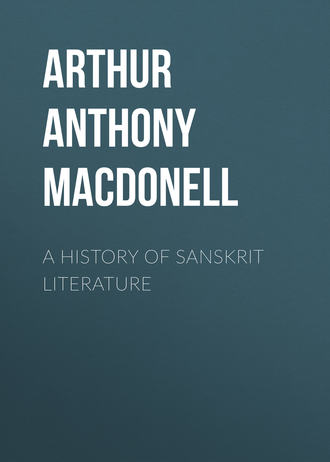 полная версия
полная версияA History of Sanskrit Literature
M’Crindle, Ancient India as Described by Classical Authors, 5 vols., especially vol. v., Invasion of India by Alexander, London, 1896. Weber, Die Griechen in Indien, in Transactions (Sitzungsberichte) of the Roy. Prussian Acad., Berlin, 1890. Sylvain Lévi, Quid de Græcis veterum Indorum monumenta tradiderint, Paris, 1890; also La Grèce et l’Inde (in Revue des Etudes Grecques), Paris, 1891. Goblet d’Alviella, Ce que l’Inde doit à la Grèce, Paris, 1897; also Les Grecs dans l’Inde, and Des Influences Classiques dans la Culture Scientifique et Littéraire de l’Inde, in vols. xxxiii., xxxiv. (1897) of Bulletin de l’Académie Royale de Belgique. L. de la Vallée Poussin, La Grèce et l’Inde, in Musée Belge, vol. ii. pp. 126–152. Vincent A. Smith, Græco-Roman Influence on the Civilisation of Ancient India in Journal of As. Soc. of Bengal, 1889–92. O. Franke, Beziehungen der Inder zum Westen, Journ. of Germ. Or. Soc., 1893, pp. 595–609. M. A. Stein in Indian Antiquary, vol. xvii. p. 89. On foreign elements in Indian art see Cunningham, Archæological Survey of India, vol. v. pp. 185 ff.; Grünwedel, Buddhistische Kunst, Berlin, 1893; E. Curtius, Griechische Kunst in Indien, pp. 235–243 in vol. ii. of Gesammelte Abhandlungen, Berlin, 1894; W. Simpson, The Classical Influence in the Architecture of the Indus Region and Afghanistan, in the Journal of the Royal Institution of British Architects, vol. i. (1894), pp. 93–115. P. 413: On the Çakas and Kushanas, see Rapson, Indian Coins, pp. 7 and 16, in Bühler’s Encyclopædia, Strasburg, 1898. On the relation of Indian to Greek fables, cf. Weber in Indische Studien, vol. iii. p. 327 ff. Through the medium of Indian fables and fairy tales, which were so popular in the Middle Ages, the magic mirror and ointment, the seven-league boots, the invisible cap, and the purse of Fortunatus (cf. Burnell, Sāmavidhāna Brāhmaṇa, preface, p. xxxv), found their way into Western literature. For possible Greek influence on Indian drama, cf. Windisch, in Trans. of the Fifth Oriental Congress, part ii., Berlin, 1882. On chess in Sanskrit literature, cf. Macdonell, Origin and Early History of Chess, in Journ. Roy. As. Soc., 1898. On Indian influence on Greek philosophy, cf. Garbe in Sānkhya und Yoga, p. 4. L. von Schroeder, Buddhismus und Christenthum, Reval, 2nd ed., 1898. P. 422–23: It seems quite possible to account for the ideas of the Neo-Platonists from purely Hellenic sources, without assuming Indian influence. On the relation of Çakuntalā to Schiller (Alpenjäger) and Goethe (Faust), cf. Sauer, in Korrespondenzblatt für die Gelehrten und Realschulen Württembergs, vol. xl. pp. 297–304; W. von Biedermann, Goetheforschungen, Frankfurt a/M., 1879, pp. 54 ff. (Çakuntalā and Faust). On Sanskrit literature and modern poets (Heine, Matthew Arnold), cf. Max Müller, Coincidences, in the Fortnightly Review, New Series, vol. lxiv. (July 1898), pp. 157–162.
1
vii. 59, 12; x. 20, 1; 121, 10; 190, 1–3.
2
The other three systems are: (1) that of the Maitrāyaṇī and Kāṭhaka Saṃhitās (two recensions of the Black Yajurveda), which mark the acute with a vertical stroke above; (2) that of the Çatapatha Brāhmaṇa, which marks the acute with a horizontal stroke below; and (3) that of the Sāmaveda, which indicates the three accents with the numerals 1, 2, 3, to distinguish three degrees of pitch, the acute (1) here being the highest.
3
In verse 10, which is a late addition; see p. 51, footnote.
4
A reference to dropsy, with which Varuṇa is thought to afflict sinners.
5
The sun is probably meant.
6
The component parts of this name are in Sanskrit pancha, five, and āp, water.
7
From the Sanskrit dakshiṇa, south, literally “right,” because the Indians faced the rising sun when naming the cardinal points.
8
German, vieh; Latin, pecus, from which pecunia, “money.”
9
The word “frolic” alludes to the assembly-house (sabhā) being a place of social entertainment, especially of gambling.
10
Na nonanunno nunnono nānā nānānanā nanu
Nunno ’nunno nanunneno nānenā nunnanunnanut.
11
Devākānini kāvāde, &c.
12
Referring to the poetical belief that the açoka only blossoms when struck by the foot of a beautiful girl.
13
E.g. amala-kamala-dala-lochana bhava-mochana.
14
It is interesting to note that two Sanskrit plays, composed in the twelfth century, and not as yet known in manuscript form, have been partially preserved in inscriptions found at Ajmere (see Kielhorn, in Appendix to Epigraphia Indica, vol. v. p. 20, No. 134. Calcutta, 1899).

